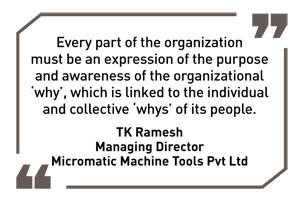Internalizing the ‘Why’ Question

In the preceding issues, we have been discussing setting goals, getting there, unlearning to learn, reaching objectives, etc. Perhaps we need to formally bring in the question ‘Why?’. Among all, this seems to be the most fundamental question. It is the conceptual objective framework of engagement and should be in prime consideration for decision-making across the organization. While we use and are aware of the terms ‘goals & objectives’, how do we internalize them as individuals, as departments and, holistically, across the organization?
 While both goals & objectives provide the foundations for measurement, goals are the outcome statement of what the organization is trying to accomplish, whereas objectives are precise time-based actions that are measurable and support the accomplishment of the organization’s goal.
While both goals & objectives provide the foundations for measurement, goals are the outcome statement of what the organization is trying to accomplish, whereas objectives are precise time-based actions that are measurable and support the accomplishment of the organization’s goal.
 However, there has always been some confusion about the term ‘objective’. Is it an aim or an end? In daily parlance, it is used as a guide to intermediary decisions and actions. As an example, on the sales front, it is common to say we should have our sales engineers make as many calls as possible but fundamentally the objective is the sales volume. It is not rare that in larger organizations, in situations when we lose sight of the objective, we multiply our efforts. In an organization, if we ask key people across the spectrum to write down their principal objectives, we get conflicting perspectives. The Product Development team could be making investments in areas that are not in sync with markets. The Supply Chain team could be pursuing partners that are not in sync with the scaling needs etc. Committees could very well be wasting resources thrashing out-of-sync problems.
However, there has always been some confusion about the term ‘objective’. Is it an aim or an end? In daily parlance, it is used as a guide to intermediary decisions and actions. As an example, on the sales front, it is common to say we should have our sales engineers make as many calls as possible but fundamentally the objective is the sales volume. It is not rare that in larger organizations, in situations when we lose sight of the objective, we multiply our efforts. In an organization, if we ask key people across the spectrum to write down their principal objectives, we get conflicting perspectives. The Product Development team could be making investments in areas that are not in sync with markets. The Supply Chain team could be pursuing partners that are not in sync with the scaling needs etc. Committees could very well be wasting resources thrashing out-of-sync problems.
Along with the clarity of objectives, the balance among the objectives and their connection to the goals is to be understood and internalized across the organization. An organization is not a singular or a small group of well-harmonized individuals, but it consists of many groups of functional structure like service, accounts, production, quality, etc. So, unless there is a strong ‘why?’ across the enterprise, it is difficult for an engaged interaction among people working together or for leadership to try organizing them.
While people derive social satisfaction from working together, they build up, often unconsciously, elaborate codes of behavior, loyalties, likes, and dislikes that have little to do with the organization. Thus, every part of the organization must be an expression of the purpose and awareness of the organizational ‘why’, which is linked to the individual and collective ‘whys’ of its people. An organization with a clear purpose is easy to understand and manage across levels and produces effective sustainable results.
The views expressed by the author are personal and he can be contacted at rameshtkr@gmail.com
TK Ramesh
Managing Director
Micromatic Machine Tools Pvt Ltd





 Facebook
Facebook Twitter
Twitter Linkedin
Linkedin Subscribe
Subscribe